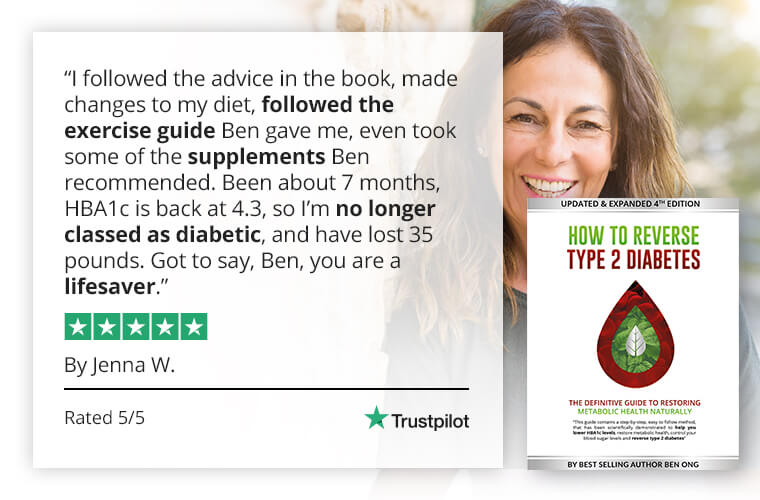- What is Ozempic (Semaglutide)?
- How does Ozempic work?
- Foods to avoid while taking Ozempic
- What foods should you eat while taking Ozempic?
- Are there any other things to avoid while taking Ozempic?
- Should you take Ozempic with food?
- Best time to take Ozempic
- Any other safety concerns?
- Ben’s Type 2 Diabetes Supplement: Glucose Control
- Ben’s Best-Selling Book: How To Reverse Type 2 Diabetes
- Conclusion
- About The Author
- Source
If you’re taking the medication Ozempic (Semaglutide), you may wonder what foods you should avoid and which foods to eat.
There aren’t any foods that interact with Ozempic, but eating certain foods while taking Ozempic can increase your risk of adverse side effects, such as nausea and diarrhea.
Keep reading to learn more about Ozempic and your diet, including what to eat and why.
What is Ozempic (Semaglutide)?
Ozempic is a medication used to treat type 2 diabetes. It’s a type of GLP-1 receptor agonist whose drug name is semaglutide. Ozempic isn’t for patients with type 1 diabetes.
Ozempic is an injectable type 2 diabetes medication. It’s meant to be taken once weekly instead of daily, which is one of its advantages.
Ozempic may also help you lose weight. Patients taking medication like Ozempic lose an average of 3-5.5 pounds, but you may notice more weight loss if you make healthy lifestyle changes as well.
| Dosage | Frequency | Administration |
| 0.25mg | Once a week | Subcutaneous |
| 0.5mg | Once a week | Subcutaneous |
| 1mg | Once a week | Subcutaneous |
The typical dose of Ozempic is 0.25 milligrams once weekly for four weeks, then 0.5 milligrams weekly for at least four weeks. If blood sugar targets aren’t being met with 0.5 milligrams weekly, the dose can be increased to a maximum of 1 milligram weekly.
How does Ozempic work?
If you have type 2 diabetes, your body likely doesn’t produce enough or respond to the hormone insulin. Insulin helps lower blood glucose (blood sugar) levels when they rise.
Ozempic is a part of a drug class called GLP-1 receptor agonists. GLP-1 receptors in your pancreas help increase insulin secretion while reducing glucagon secretion, a hormone that raises blood sugar levels. GLP-1 receptor agonists activate these receptors to help control blood sugar levels.
Ozempic weight loss may occur because the medication helps reduce hunger and promotes fullness by slowing stomach emptying.

Foods to avoid while taking Ozempic
There aren’t any specific foods you should avoid while taking Ozempic. However, to maintain healthy blood sugar levels, it’s recommended to limit or avoid some of the following foods while you’re receiving Ozempic treatment:
1. Refined grains
Refined grains are stripped of their nutrient- and fiber-rich parts, leaving behind a lower-fiber, lower-nutrient grain. These types of grains are more likely to raise your blood sugar levels. Refined grains can also impact your cholesterol levels and heart health.
White bagels, flour tortillas, white bread, and white rice are just a few examples of refined grains to avoid on an Ozempic diet. Consider looking for some healthy bread alternatives instead.
2. Foods with added sugar
Added sugar isn’t always easy to spot. Sugar is added to foods that might otherwise seem healthy, like yogurt, dried fruit, some nutrition bars, and granola.
Check the nutrition facts label and try to avoid eating foods with more than five grams of added sugar per serving often, or at least watch your portion sizes. Aim to keep your added sugar intake below 30 grams per day on an Ozempic diet.
3. Fried foods
Ozempic may cause nausea and stomach upset, especially as your body is getting used to it. If you experience nausea from taking Ozempic, you should avoid fried foods.
Other things that can help ease nausea include eating bland, dry foods, choosing cold foods, and eating smaller meals throughout the day.
4. Sugary drinks
Sugary beverages are the leading contributor of added sugar in a typical Western diet. Drinks like soda, sweetened teas, sugary coffee drinks, energy drinks, and many more are very high in added sugar.
Regularly drinking sugary drinks can make it difficult to manage your blood sugar levels. Poorly-controlled diabetes can lead to complications like diabetic retinopathy (eye damage), nerve damage, and heart disease.
5. Alcohol
Alcohol isn’t forbidden on an Ozempic diet, but you should take caution when drinking alcohol on any diabetes medication. It can lower your blood sugar by reducing the amount of sugar released by your liver.
Ozempic helps lower your blood sugar, so combining ozempic and alcohol could lead to low blood sugar.
If you choose to include alcohol in your Ozempic diet, then be sure to eat a meal when you drink and try to avoid having more than one drink a day for women and more than two drinks a day for men.

What foods should you eat while taking Ozempic?
Now you know what foods to avoid while taking Ozempic, find out 5 foods you should eat.
1. Non-starchy vegetables
Most vegetables are low in carbs and rich in fiber, so they don’t raise blood sugar levels significantly. Vegetables are also a great source of vitamins and minerals.
Aim to include plenty of non-starchy vegetables in an Ozempic diet, such as:
- Artichoke
- Asparagus
- Beans (green, wax, Italian)
- Beets
- Brussels sprouts
- Broccoli
- Cabbage (green, bok choy, Chinese)
- Carrots
- Cauliflower
- Eggplant
- Green leafy vegetables (collard, kale, mustard, turnip)
- Jicama
- Kohlrabi
- Leeks
- Mushrooms
- Okra
- Onions
- Peapods
- Peppers
- Radishes
- Rutabaga
- Salad greens (chicory, endive, escarole, lettuce, romaine, spinach, arugula, radicchio, watercress)
- Sprouts
- Squash (cushaw, summer, crookneck, spaghetti, zucchini)
- Sugar snap peas
- Swiss chard
- Tomatoes
- Turnips
2. Whole grains
Grains are a type of carbohydrate, which are nutrients that turn into blood sugar. However, whole grains are considered “healthy” carbs to include in your Ozempic diet.
Whole grains are rich in fiber, a type of carbohydrate that doesn’t raise your blood sugar level. The higher the fiber content, the less impact the food will have on your blood sugar.
A few examples of whole grains are oatmeal, brown rice, whole wheat bread, bulgur, barley, and whole-wheat pasta. Whole grains are also richer in protein than refined grains like white rice and white bread.
3. Nuts
Nuts are composed mainly of healthy unsaturated fats as well as protein and fiber. These healthy fats can help improve your heart health as well.
Eating a diet rich in heart-healthy fats may help reduce your risk of heart disease, including heart attack and stroke.
Fats and protein don’t raise your blood sugar, so they can be beneficial in an Ozempic diet. You should include protein with all meals and snacks to support stable blood sugar levels.
Eating protein and fat with carbohydrates can help slow the rise in blood glucose after eating. For example, eating a handful of nuts along with some fresh fruit will likely raise blood sugar less than eating fruit alone.
4. Protein-rich foods
According to the Plate Method for Diabetes, one-quarter of your plate should consist of protein at meals, and the same is true for an Ozempic diet.
Protein doesn’t raise your blood sugar significantly, and it helps boost satiety, which means it can help you stay fuller between meals.
Good sources of protein:
5. Legumes
Legumes like beans and lentils are a great plant-based source of protein. They’re also packed with fiber and beneficial nutrients like iron, magnesium, and folate.
Legumes are a type of starchy vegetable, so they contain more carbs than nonstarchy vegetables. Balancing legumes with non-starchy vegetables and protein can help prevent a spike in blood sugar levels from eating starchy vegetables.
Are there any other things to avoid while taking Ozempic?
- Taking Ozempic with injectable insulin or sulfonylureas could result in low blood sugar, but it isn’t contraindicated to take Ozempic with these medications.
- You should avoid drinking excessive amounts of alcohol while taking Ozempic. While rare, there is a risk of pancreatitis (inflammation of your pancreas) while taking Ozempic.
Binge drinking and chronic, heavy alcohol use increases your risk of pancreatitis, which is why you should be careful about how much alcohol you consume while on Ozempic.
Should you take Ozempic with food?
Ozempic can be taken with or without food, according to the drug manufacturer.
Best time to take Ozempic
The best time to take Ozempic is on the same day every week. If you want to change the day of the week you take your Ozempic injection, you can, as long as it’s been at least two days since your last Ozempic dose.
If you miss a dose of Ozempic, you can take it within five days after the missed dose. But if it’s been longer than five days, skip the missed dose and take your next dose as scheduled.
Get Your FREE Diabetes Diet Plan
- 15 foods to naturally lower blood sugar levels
- 3 day sample meal plan
- Designed exclusively by our nutritionist
Any other safety concerns?
Side effects of Ozempic
As with any medication, there are potential side effects from taking Ozempic. The most common side effects reported among patients taking Ozempic include:
- Nausea
- Diarrhea
- Vomiting
- Stomach pain
- Constipation
You should contact your healthcare provider if you experience any of the following side effects from taking Ozempic:
- A change in vision – Ozempic is associated with a higher rate of diabetic retinopathy compared to other types of diabetes medications.
- Severe stomach pain that won’t go away (could be pancreatitis).
- Low blood sugar.
- Symptoms of an allergic reaction, such as swelling of your face, lips, tongue, or throat; problems breathing or swallowing; severe rash or itching; fainting or feeling dizzy; or very rapid heartbeat.
Ozempic causes delayed stomach emptying, which may worsen symptoms in patients with gastroparesis. (If you have gastroparesis, you should avoid high-fat, high-fiber foods.)
Possible thyroid cancer
There is a chance that Ozempic may cause thyroid cancer. You shouldn’t take Ozempic if you have a history of thyroid cancer or a thyroid tumor.
You should also avoid taking Ozempic if anyone in your family has a history of medullary thyroid carcinoma, a type of thyroid cancer.
Pregnancy and lactation
Taking Ozempic during pregnancy could harm your unborn baby, so you should stop taking it two months before you plan to get pregnant. It’s recommended to avoid taking Ozempic while breastfeeding as well.
Interactions with medications
Some medications can interact with Ozempic. Be sure to inform your healthcare provider and pharmacist of all other medications you are taking.
Ben’s Type 2 Diabetes Supplement: Glucose Control
Glucose Control, a natural supplement for type 2 diabetes, contains clinically proven, natural ingredients to help stabilize and maintain an optimal blood sugar level.
Clinically formulated, Glucose Control works to regenerate your pancreas, aid weight loss, alleviate diabetic symptoms, and prevent the progression of diabetes.

Each ingredient has been thoroughly researched and scientifically proven to improve and maintain type 2 diabetes health.
Ben’s Best-Selling Book: How To Reverse Type 2 Diabetes
Our best-selling book, How To Reverse Type 2 Diabetes, combines scientific research and modern medicine with holistic healing.
The book lays out an easy step-by-step method to lower your HBA1c levels, restore insulin health, and reverse type 2 diabetes, in less than 90 days without using drugs or side effects!

How To Reverse Type 2 Diabetes contains complete diabetes diet and exercise plans. This, therefore, makes it the definitive guide to reversing type 2 diabetes and achieving type 2 diabetes remission.
Conclusion
An Ozempic diet is one that also helps prevent high blood sugar. If you’re taking Ozempic, you should aim to include fruits, vegetables, whole grains, healthy fats, and protein-rich foods in your diet.
Avoid refined grains, large amounts of added sugar, excessive alcohol intake, and fried foods while taking Ozempic.
About The Author
Explore More








